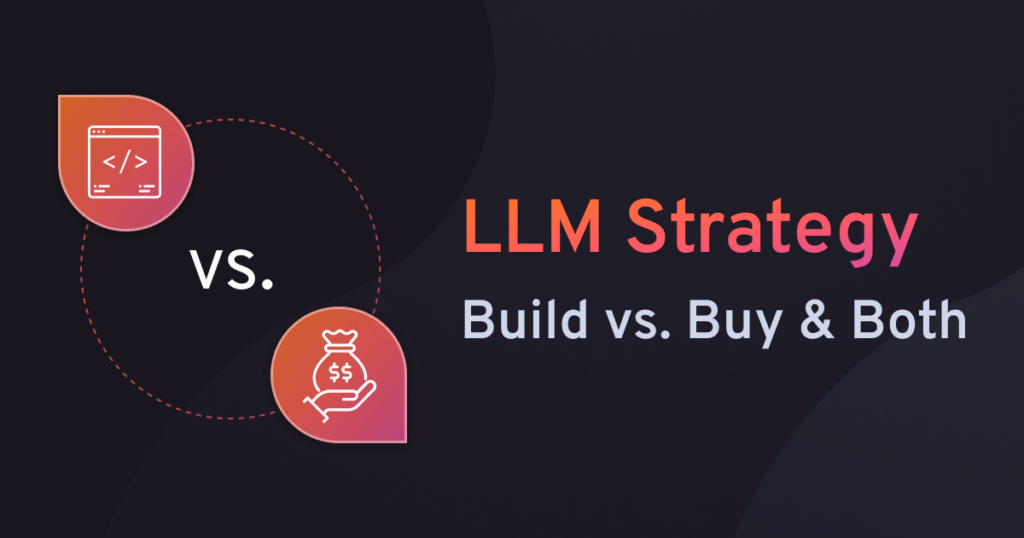Which One is the Right LLM Strategy: Build vs Buy or Both
When organizations consider adopting a Generative AI or an AI solution, one pivotal question emerges: What is the best LLM strategy for an organization? should they build a custom LLM solution, buy an off-the-shelf product, or perhaps do both?
With the advent of Large Foundational Models (LFMs) such as those offered by OpenAI, Microsoft Azure OpenAI, Google Vertex AI, and Meta LLama2, the capabilities of AI in identifying and enhancing customer engagement have significantly increased.

However, harnessing these technologies is not without challenges, especially when it comes to fine-tuning LLMs with custom data, integrating with enterprise systems, and providing a seamless user experience (UX) across different channels.
6 Key Consideration Factors for Large Language Model Integration
Integrating Large Language Models (LLMs) into business or technological frameworks involves nuanced considerations, particularly from a data science perspective. Here’s an in-depth analysis of the key factors:
1- Cost
The financial aspect of LLM integration is a complex equation. It’s not just about the initial investment in either building or buying a model. You have to consider the long-term costs associated with maintenance, updates, and potential scaling.
For a custom-built model, the costs include data collection, processing, and the computational power necessary for training. On the other hand, a pre-built LLM may come with subscription fees or usage costs.
2- Large Language Models Fine-Tuning Conundrum
Delving into the world of LLMs introduces us to a collection of intricate architectures capable of understanding and generating human-like text. The ability of these models to absorb and process information on an extensive scale is undeniably impressive.
However, enterprises and companies seeking to employ these models for bespoke virtual assistants are quickly confronted with a nontrivial challenge: fine-tuning.
Fine-tuning an LLM with customer-specific data is a complex task like LLM evaluation that requires deep technical expertise. It is not merely about feeding the model with data; rather, it involves curating the right datasets that represent the brand’s voice, understanding the nuances of various customer segments, and establishing relevance by teaching the model to prioritize customer privacy and data security.
The intricacy of fine-tuning lies in adjusting the model’s parameters so that it can grasp and adhere to a company’s unique terminology, policies, and procedures. Such specificity is not only necessary for maintaining brand consistency but is also essential for ensuring accurate, relevant, and compliant responses to user inquiries.
3- Control
Developing an LLM from scratch provides unparalleled control over its design, functionality, and the data it’s trained on. This control is critical for applications where specific behaviors or outputs are required. However, this comes with the responsibility of managing and updating the model, which requires a dedicated team of data scientists and ML engineers.
4- Compatibility with Existing Infrastructure
The integration of an LLM should complement and enhance existing systems. This involves ensuring compatibility with current data formats, software, and hardware infrastructures.
For organizations with advanced data processing and storage facilities, building a custom LLM might be more feasible. Conversely, smaller organizations might lean towards pre-trained models that require less technical infrastructure.
5- Customizability
The extent to which an LLM can be tailored to fit specific needs is a significant consideration. Custom-built models typically offer high levels of customization, allowing organizations to incorporate unique features and capabilities.
Pre-trained models, while less flexible, are evolving to offer more customization options through APIs and modular frameworks.
6- Security
Security is a paramount concern, especially when dealing with sensitive or proprietary data. Custom-built models require robust security protocols throughout the data lifecycle, from collection to processing and storage.
Pre-trained models may offer built-in security features, but it’s crucial to assess their adequacy for your specific data privacy and security requirements. This is where the concept of an LLM Gateway becomes pivotal, serving as a strategic checkpoint to ensure both types of models align with the organization’s security standards.
Each of these factors requires a careful balance between technical capabilities, financial feasibility, and strategic alignment. The choice between building, buying, or combining both approaches for LLM integration depends on the specific context and objectives of the organization.

The Build vs Buy vs Both Dilemma
The “Build vs Buy vs Both” dilemma in Large Language Model (LLM) integration can be reframed as follows:
Building LLM
Opting for a custom-built LLM allows organizations to tailor the model to their own data and specific requirements, offering maximum control and customization. This approach is ideal for entities with unique needs and the resources to invest in specialized AI expertise.
The downside is the significant investment required in terms of time, financial data and resources, and ongoing maintenance.
Open-source LLMs (Build LLMs)
differ from pre-trained models by offering customization and training flexibility. They are fully accessible for modifications to meet specific needs, with examples including Google’s BERT and Meta’s LLaMA. These models require significant input in terms of training data and computational resources but allow for a high degree of specialization.
Utilizing frameworks like Hugging Face’s Transformers, users can fine-tune these models for tailored applications, demanding more in-depth technical knowledge in machine learning and NLP.
Benefits of Open-source LLMs
Open-source LLMs offer substantial flexibility and customization, especially beneficial for tasks requiring specific model training. Unlike pre-trained LLMs, they provide greater freedom in selecting training data and adjusting the model’s architecture, enhancing the accuracy for particular use cases.
They also ensure better data security, as the training data remains within the user’s control. Moreover, open-source LLMs foster a collaborative environment among developers globally, as evidenced by various models on platforms.
Buying LLM
Purchasing a pre-built LLM is a quicker and often more cost-effective option. It offers the advantage of leveraging the provider’s expertise and existing integrations. This option suits organizations seeking a straightforward, less resource-intensive solution, particularly those without the capacity for extensive AI development.
Pre trained model (Buy LLMs)
Pre-trained Large Language Models (LLMs), commonly referred to as “Buy LLMs,” are models that users can utilize immediately after their comprehensive training phase. These models, available through subscription plans, eliminate the need for users to engage in the training process.
The primary advantage of these pre-trained LLMs lies in their continual enhancement by their providers, ensuring improved performance and capabilities. They are trained on extensive text data using unsupervised learning techniques, allowing for accurate predictions. The training process involves collecting and preprocessing a vast amount of data, followed by parameter adjustments to minimize the deviation between predicted and actual outcomes.
Benefits of Pre-trained LLMs
The benefits of pre-trained LLMs, like AiseraGPT, primarily revolve around their ease of application in various scenarios without requiring enterprises to train. Buying an LLM as a service grants access to advanced functionalities, which would be challenging to replicate in a self-built model.
These models stand out for their efficiency in time and cost, bypassing the need for extensive data collection, preprocessing, training, and ongoing optimization required in model development.
Furthermore, their integration is streamlined via APIs, simplifying the process for developers. Users can also refine the outputs through prompt engineering, enhancing the quality of results without needing to alter the model itself.
Both (LLM Hybrid Approach)
A hybrid approach involves using a base LLM provided by a vendor and customizing it to some extent with organization-specific data and workflows. This method balances the need for customization with the convenience of a pre-built solution, suitable for those seeking a middle ground.
Conclusion
In the realm of large language model implementation, there is no one-size-fits-all solution. The decision to build, buy, or adopt a hybrid approach hinges on the organization’s unique needs, technical capabilities, budget, and strategic objectives. It is a balance of controlling a bespoke experience versus leveraging the expertise and resources of AI platform providers.
Regardless of the chosen path, organizations should not underestimate the complexity of the technical challenges involved in large language models for healthcare or leveraging large language models in financial services, that excel in fine-tuning and enterprise integration.
Each route of development involves recognizing the ongoing journey of embracing AI—nurturing it from a nascent technology into a sophisticated tool that enhances customer interactions and business operations alike. You can book a custom AI demo for your enterprise to experience AiseraLLM today!
